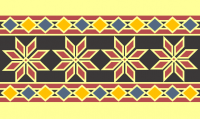Difference between revisions of "Archive:Thuun"
| Line 65: | Line 65: | ||
{| border="1" cellpadding="1" cellspacing="1" class="bluetable lightbluebg" style="text-align:center;" | {| border="1" cellpadding="1" cellspacing="1" class="bluetable lightbluebg" style="text-align:center;" | ||
! | ! | ||
! | ! Bilabial | ||
! Alveolar | ! Alveolar | ||
! Dorsal | ! Dorsal | ||
Revision as of 05:13, 29 May 2016
| Thuun | |
|---|---|
| Tuum | |
 | |
| Pronunciation | [tʉ:m] |
| Native speakers | ~ 300 000 (2015) |
| Language family | East-Mirarian
|
| Writing system | Kuoggvi / Mahavic |
| Official status | |
| Official language in | Uvanga |
| CWS code | UO1 |
Background
Thuun (Tuum /tʉ:m/) is the primary language of Uvanga, and is distantly related to Mahavic and Elipo-Sucaelian. It has over 100 vowels but only 9 consonants.
Phonology
Consonants
| Bilabial | Alveolar | Dorsal | |
|---|---|---|---|
| Nasal | m | n | ŋ |
| Plosive | p | t | k |
| Fricative | s | ||
| Approximant | l | j |
Vowels
| Front | Back | |||
|---|---|---|---|---|
| Unrounded | Rounded | Unrounded | Rounded | |
| Close | i i: i:: | y y: y:: | ʉ ʉ: ʉ:: | |
| Mid | e e: e:: | ø ø: ø:: | ɤ ɤ: ɤ:: | o o: o:: |
| Open | æ æ: æ:: | ɑ ɑ: ɑ:: | ||
These vowels can combine to form up to almost 80 phonemic polyphthongs, including length distinctions.
Phonotactics
(C)V(C) syllable structure, where /ŋ/ cannot appear initially and /j/ cannot appear finally.
Thuun has a system of vowel harmony. A word cannot contain both front and back vowels, so affixes automatically adapt to the same backness as the stem. The only neutral vowel is /i/, which can occur in words of either backness.
Orthography
| a /ɑ/ |
ä /æ/ |
e /ɤ/ |
ë /e/ |
i /i/ |
j /j/ |
k /k/ |
l /l/ |
m /m/ |
n /n/ |
ng /ŋ/ |
o /o/ |
ö /ø/ |
p /p/ |
s /s/ |
t /t/ |
u /ʉ/ |
y /y/ |
Long and overlong vowels are written doubled or tripled, eg. <ää> /æ:/, äää /æ::/
Diphthongs are written with their components side by side, eg. <ië> /ie̯:/, <iië> /ie̯::/
Grammar
Morphology
Thuun is highly synthetic and almost exclusively suffixing. Suffixes attach agglutinatively, but are usually fusional for multiple morphemes, such as person, number, tense, and negativity.
Syntax
The word order is fairly unrestrictive, but tends to be SVO.